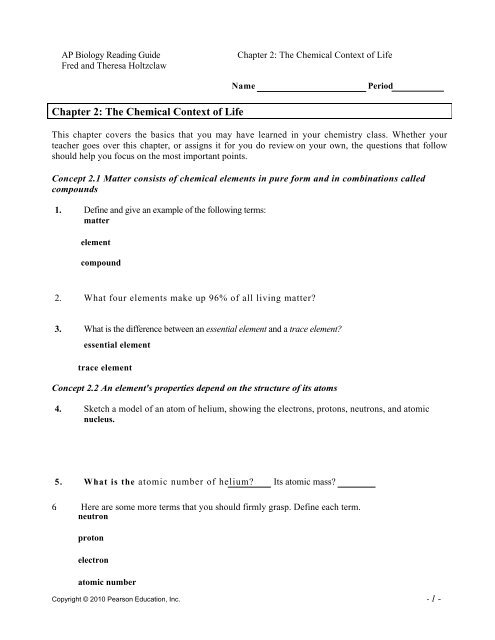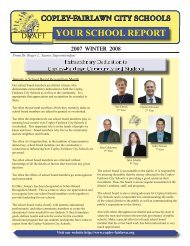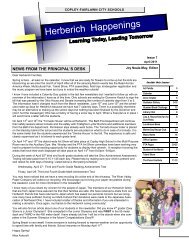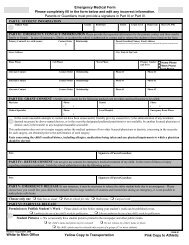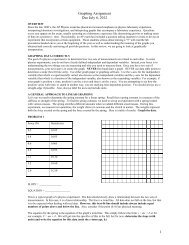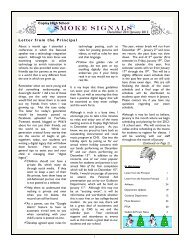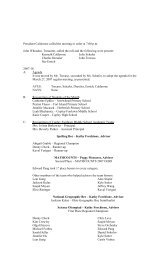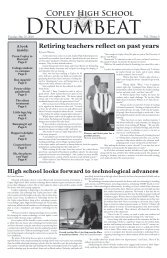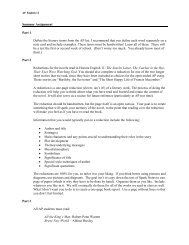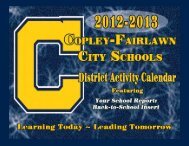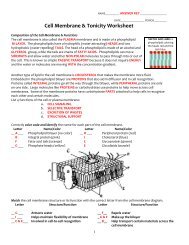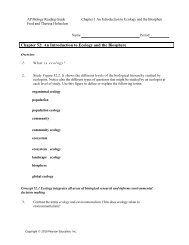Chapter 2: The Chemical Context of Life - Copley-Fairlawn City
Chapter 2: The Chemical Context of Life - Copley-Fairlawn City
Chapter 2: The Chemical Context of Life - Copley-Fairlawn City
You also want an ePaper? Increase the reach of your titles
YUMPU automatically turns print PDFs into web optimized ePapers that Google loves.
AP Biology Reading Guide <strong>Chapter</strong> 2: <strong>The</strong> <strong>Chemical</strong> <strong>Context</strong> <strong>of</strong> <strong>Life</strong><br />
Fred and <strong>The</strong>resa Holtzclaw<br />
Name<br />
Period<br />
<strong>Chapter</strong> 2: <strong>The</strong> <strong>Chemical</strong> <strong>Context</strong> <strong>of</strong> <strong>Life</strong><br />
This chapter covers the basics that you may have learned in your chemistry class. Whether your<br />
teacher goes over this chapter, or assigns it for you do review- on your own, the questions that follow<br />
should help you focus on the most important points.<br />
Concept 2.1 Matter consists <strong>of</strong> chemical elements in pure form and in combinations called<br />
compounds<br />
1. Define and give an example <strong>of</strong> the following terms:<br />
matter<br />
element<br />
compound<br />
2. What four elements make up 96% <strong>of</strong> all living matter?<br />
3. What is the difference between an essential element and a trace element?<br />
essential element<br />
trace element<br />
Concept 2.2 An element's properties depend on the structure <strong>of</strong> its atoms<br />
4. Sketch a model <strong>of</strong> an atom <strong>of</strong> helium, showing the electrons, protons, neutrons, and atomic<br />
nucleus.<br />
5. What is the atomic number <strong>of</strong> helium? Its atomic mass?<br />
6. Here are some more terms that you should firmly grasp. Define each term.<br />
neutron<br />
proton<br />
electron<br />
atomic number<br />
Copyright © 2010 Pearson Education, Inc. - 1 -
AP Biology Reading Guide <strong>Chapter</strong> 2: <strong>The</strong> <strong>Chemical</strong> <strong>Context</strong> <strong>of</strong> <strong>Life</strong><br />
Fred and <strong>The</strong>resa Holtzclaw<br />
atomic mass<br />
isotope<br />
electron shells<br />
energy<br />
7. Consider this entry in the periodic table for carbon.<br />
What is the atomic mass? _______ atomic number? _______<br />
How many electrons does carbon have? _________ neutrons?<br />
6<br />
C<br />
12<br />
8. Which is the only subatomic particle that is directly involved in the chemical reactions<br />
between atoms?<br />
9. What is potential energy?<br />
10. Explain which has more potential energy in each pair:<br />
a. boy at the top <strong>of</strong> a slide/boy at the bottom<br />
b. electron in the first energy shell/electron in the third energy shell<br />
c. water/glucose<br />
Copyright © 2010 Pearson Education, Inc. - 2 -
AP Biology Reading Guide <strong>Chapter</strong> 2: <strong>The</strong> <strong>Chemical</strong> <strong>Context</strong> <strong>of</strong> <strong>Life</strong><br />
Fred and <strong>The</strong>resa Holtzclaw<br />
11. What determines the chemical behavior <strong>of</strong> an atom?<br />
12. Here is an electron distribution diagram for sodium:<br />
a. How many valence electrons does it have? _____ Circle the valence<br />
electron(s).<br />
b. How many protons does it have? ___<br />
Concept 2.3 <strong>The</strong> formation and function <strong>of</strong> molecules depend on chemical bonding between atoms<br />
13. Define molecule.<br />
14. Now, refer back to your definition <strong>of</strong> a compound and fill in the following chart:<br />
Molecule? (y/n) Compound? (y/n) Molecular Formula Structural Formula<br />
Water<br />
Carbon dioxide<br />
Methane<br />
02 02<br />
15. What type <strong>of</strong> bond is seen in 02? Explain what this means.<br />
16. What is meant by electronegativity?<br />
17. Explain the difference between a nonpolar covalent bond and a polar covalent bond.<br />
Copyright © 2010 Pearson Education, Inc. - 3 -
AP Biology Reading Guide <strong>Chapter</strong> 2: <strong>The</strong> <strong>Chemical</strong> <strong>Context</strong> <strong>of</strong> <strong>Life</strong><br />
Fred and <strong>The</strong>resa Holtzclaw<br />
18. Make an electron distribution diagram <strong>of</strong> water. Which element is most electronegative? Why<br />
is water considered a polar molecule? Label the regions that are more positive or more<br />
negative. (This is a very important concept. Spend some time with this one!)<br />
19. Another bond type is the ionic bond. Explain what is happening in the figure below (2.14):<br />
•••<br />
-<br />
0<br />
20. What two elements are involved above?<br />
21. Define anion and cation. In the preceding example, which is the anion?<br />
22. What is a hydrogen bond? Indicate where the hydrogen bond occurs in this figure.<br />
23. Explain van der Waals interactions. Though they represent very weak attractions, when these<br />
interactions are numerous they can stick a gecko to the ceiling!<br />
Copyright © 2010 Pearson Education, Inc. - 4 -
AP Biology Reading Guide <strong>Chapter</strong> 2: <strong>The</strong> <strong>Chemical</strong> <strong>Context</strong> <strong>of</strong> <strong>Life</strong><br />
Fred and <strong>The</strong>resa Holtzclaw<br />
24. Here is a list <strong>of</strong> the types <strong>of</strong> bonds and interactions discussed in this section. Place them in<br />
order from the strongest to the weakest: hydrogen bonds, van der Waals interactions, covalent<br />
bonds, ionic bonds.<br />
STRONG<br />
WEAK<br />
25. Use morphine and endorphins as examples to explain why molecular shape is crucial in biology.<br />
Concept 2.4 <strong>Chemical</strong> reactions make and break chemical bonds<br />
26. Write the chemical shorthand equation for photosynthesis. Label the reactants and the<br />
products.<br />
27. For the equation you just wrote, how many molecules <strong>of</strong> carbon dioxide are there? _<br />
How many molecules <strong>of</strong> glucose? ___________ How many elements in glucose? _________<br />
28. What is meant by dynamic equilibrium? Does this imply equal concentrations <strong>of</strong> each reactant<br />
and product?<br />
Testing Your Knowledge: Self-Quiz Answers<br />
Now you should be ready to test your knowledge. Place your answers here:<br />
Copyright © 2010 Pearson Education, Inc. - 5 -
AP Biology Reading Guide <strong>Chapter</strong> 2: <strong>The</strong> <strong>Chemical</strong> <strong>Context</strong> <strong>of</strong> <strong>Life</strong><br />
Fred and <strong>The</strong>resa Holtzclaw<br />
1. 2. 3. 4, 5. 6. 7. 8.<br />
Copyright © 2010 Pearson Education, Inc. - 6 -
AP Biology Reading Guide <strong>Chapter</strong> 3: Water and the Fitness <strong>of</strong> the Environment<br />
Fred and <strong>The</strong>resa Holtzclaw<br />
Name<br />
Period<br />
<strong>Chapter</strong> 3: Water and the Fitness <strong>of</strong> the Environment<br />
Concept 3.1 <strong>The</strong> polarity <strong>of</strong> water molecules results in<br />
hydrogen bonding<br />
1. Study the water molecules at the right. On the central<br />
molecule, label oxygen (0) and hydrogen (H).<br />
2. What is a polar molecule? Why is water considered polar?<br />
3. Now, add + and — signs to indicate the charged regions <strong>of</strong><br />
each molecule. <strong>The</strong>n, indicate the hydrogen bonds.<br />
4. Explain hydrogen bonding. How many hydrogen bonds can<br />
a single water molecule form?<br />
Concept 3.2 Four emergent properties <strong>of</strong> water contribute to Earth's fitness for life<br />
Hydrogen bonding accounts for the unique properties <strong>of</strong> water. Let's look at several.<br />
Cohesion<br />
5. Distinguish between cohesion and adhesion.<br />
6. What is demonstrated when you see beads <strong>of</strong> water on a waxed car hood?<br />
7. Which property explains the ability <strong>of</strong> a water strider to walk on water?<br />
Moderation <strong>of</strong> Temperature<br />
8. <strong>The</strong> calorie is a unit <strong>of</strong> heat. Define calorie.<br />
9. Water has high specific heat. What does this mean? How does water's specific heat compare to<br />
alcohol ' s?<br />
10. Explain how hydrogen bonding contributes to water's high specific heat.<br />
Copyright @ 2010 Pearson Education, Inc. 1 -
AP Biology Reading Guide <strong>Chapter</strong> 3: Water and the Fitness <strong>of</strong> the Environment<br />
Fred and <strong>The</strong>resa Holtzclaw<br />
11. Summarize how water's high specific heat contributes to the moderation <strong>of</strong> temperature. How is this<br />
property important to life?<br />
12. Define evaporation. What is heat <strong>of</strong> vaporization? Explain at least three effects <strong>of</strong> this property on<br />
living organisms.<br />
Expansion upon Freezing<br />
13. Ice floats! So what? Consider what would happen if ponds and other bodies <strong>of</strong> water accumulated ice at<br />
the bottom. Describe why this property <strong>of</strong> water is important.<br />
14. Now, explain why ice floats. Why is 4 ° C the critical temperature in this story?<br />
Solvent <strong>of</strong> <strong>Life</strong><br />
15. Review and define these terms:<br />
solvent<br />
solution<br />
solute<br />
16. Consider c<strong>of</strong>fee to which you have added sugar. Which is the solvent? <strong>The</strong> solute?<br />
17. Explain why water is such a fine solvent.<br />
18. Define hydrophobic and hydrophilic.<br />
19. You already know that some materials, such as olive oil, will not dissolve in water. In fact, oil will float<br />
on top <strong>of</strong> water. Explain this property in terms <strong>of</strong> hydrogen bonding.<br />
Copyright @ 2010 Pearson Education, Inc. 2 -
AP Biology Reading Guide <strong>Chapter</strong> 3: Water and the Fitness <strong>of</strong> the Environment<br />
Fred and <strong>The</strong>resa Holtzclaw<br />
20. Now, let's do a little work that will enable you to prepare solutions. Read the section on solute<br />
concentrations carefully, and show the calculations here for preparing a 1-molar solution <strong>of</strong> sucrose.<br />
Steps to help you do this follow. <strong>The</strong> first step is done for you. Fill in the rest.<br />
Steps to prepare a solution:<br />
a. Write the molecular formula. Ci2H22 0 11<br />
b. Use your periodic table to calculate the mass <strong>of</strong> each element. Multiply by the number <strong>of</strong> atoms <strong>of</strong><br />
the element. (For example, 0 has a mass <strong>of</strong> 16. <strong>The</strong>refore one mole <strong>of</strong> 0 has a mass <strong>of</strong> 16 x 11 =<br />
176 g/mole.)<br />
c. Add the masses <strong>of</strong> each element in the molecule.<br />
d. Add this mass <strong>of</strong> the compound to water to bring it to a volume <strong>of</strong> 1 liter. This makes 1 liter <strong>of</strong> a<br />
1-M (1 molar) solution.<br />
21. Can you prepare 1 liter <strong>of</strong> a 0.5-molar glucose solution? Show your work here.<br />
22. Define molarity.<br />
Concept 3.3 Acidic and basic conditions affect living organisms<br />
23. What two ions form when water dissociates?<br />
You should have answered "hydronium (H30+) and hydroxide ions (OH—)" in the preceding question.<br />
However, by convention, we will represent the hydronium ion as H+.<br />
24. What is the concentration <strong>of</strong> each ion in pure water at 25 ° C?<br />
25. Water has a pH <strong>of</strong> 7. pH is defined as the negative log <strong>of</strong> the hydrogen ion concentration [H+]. Can you<br />
now see how water is assigned a pH <strong>of</strong> 7?<br />
26. To go a step further, the product <strong>of</strong> H+ and OH— concentrations is constant at 10 -14 .<br />
[H+} [OH—} = 10 -14.<br />
Copyright @ 2010 Pearson Education, Inc. 3 -
AP Biology Reading Guide <strong>Chapter</strong> 3: Water and the Fitness <strong>of</strong> the Environment<br />
Fred and <strong>The</strong>resa Holtzclaw<br />
Water, which is neutral with a pH <strong>of</strong> 7, has an equal number <strong>of</strong> H+ and OH— ions. Now, define<br />
acid<br />
base<br />
27. Because the pH scale is logarithmic, each numerical change represents a 10X change in ion<br />
concentration.<br />
a. So, how many times more acidic is a pH <strong>of</strong> 3 compared to a pH <strong>of</strong> 5?<br />
b. How many times more basic is a pH <strong>of</strong> 12 compared to a pH <strong>of</strong> 8?<br />
c. Explain difference between a pH <strong>of</strong> 8 and a pH <strong>of</strong> 12 in terms <strong>of</strong> H+ concentration.<br />
28. On the pH chart, label pH 1-14. Label neutral, acid, base. Indicate<br />
the locations <strong>of</strong> pure water, urine, gastric juice, and bleach.<br />
29. Even a slight change in pH can be harmful! How do buffers moderate<br />
pH change?<br />
30. Exercise will result in the production <strong>of</strong> CO2, which will acidify the<br />
blood. Explain the buffering system that minimizes blood pH<br />
changes.<br />
31. Acid precipitation is increasing. Explain its sources.<br />
32. Discuss how CO 2 emissions affect marine life and ecosystems.<br />
Testing Your Knowledge: Self-Quiz Answers<br />
Now you should be ready to test your knowledge. Place your answers here:<br />
1. 2. 3. 4. 5. 6. 7. 8.<br />
Copyright @ 2010 Pearson Education, Inc. 4 -
AP Biology Reading Guide <strong>Chapter</strong> 4: Carbon and the Molecular Diversity <strong>of</strong> <strong>Life</strong><br />
Fred and <strong>The</strong>resa Holtzclaw<br />
Name<br />
Period<br />
<strong>Chapter</strong> 4: Carbon and the Molecular Diversity <strong>of</strong> <strong>Life</strong><br />
Concept 4.1 Organic chemistry is the study <strong>of</strong> carbon compounds<br />
1. Study this figure <strong>of</strong> Stanley Miller's experiment to<br />
simulate conditions thought to have existed on the<br />
early Earth. Explain the elements <strong>of</strong> this experiment,<br />
using arrows to indicate what occurs in various parts <strong>of</strong><br />
the apparatus.<br />
I<br />
NH 3 Nx<br />
I<br />
"Atmosphere"<br />
Electrode<br />
„Condenser<br />
Cooled water<br />
containing<br />
organic<br />
molecules<br />
Cold<br />
water<br />
Sample for<br />
chemical analysis<br />
2. What was collected in the sample for chemical analysis? What was concluded from the results <strong>of</strong> this<br />
experiment?<br />
Concept 4.2 Carbon atoms can form diverse molecules by bonding to four other atoms<br />
3. Make an electron distribution diagram <strong>of</strong> carbon. It is essential that you know the answers to these<br />
questions:<br />
a. How many valence electrons does carbon have?<br />
b. How many bonds can carbon form?<br />
b. What type <strong>of</strong> bonds does it form with other elements?<br />
4. Carbon chains form skeletons. List here the types <strong>of</strong> skeletons that can be formed.<br />
5. What is a hydrocarbon? Name two. Are hydrocarbons hydrophobic or hydrophilic?<br />
Copyright 2010 Pearson Education, Inc. 1
AP Biology Reading Guide <strong>Chapter</strong> 4: Carbon and the Molecular Diversity <strong>of</strong> <strong>Life</strong><br />
Fred and <strong>The</strong>resa Holtzclaw<br />
6. In <strong>Chapter</strong> 2 you learned what an isotope is. Since students <strong>of</strong>ten confuse this word with isomer, please<br />
define each term here and give an example.<br />
Definition<br />
Example<br />
isotope<br />
isomer<br />
7. Use this figure to identify the three types <strong>of</strong> isomers.<br />
For each type, give a key character and an example.<br />
H<br />
Fl H 1.1 H<br />
H<br />
1.<br />
H-q---14<br />
141 - H<br />
8. Give one example <strong>of</strong> enantiomers that vary<br />
in their pharmacological effect.<br />
_Iii_.,._.k..41_,1<br />
Fi_ii-C:i-ii<br />
I I i I I 1 H I<br />
H H H Ft H H<br />
X X H X<br />
C-c'<br />
/ \<br />
H H K / \ H<br />
Concept 4.3 A small number <strong>of</strong> chemical groups are key to the functioning <strong>of</strong> biological molecules<br />
CO,H<br />
H<br />
9. Here is an idea that will recur throughout your study <strong>of</strong> the function <strong>of</strong> molecules: Change the structure,<br />
change the function. You see this in enantiomers, you will see it in proteins and enzymes, and now we<br />
are going to look at testosterone and estradiol. Notice how similar these two molecules are, and yet you<br />
know what a vastly different effect each has. Label each molecule in the sketch below, and circle the<br />
differences.<br />
HO<br />
10. Define functional group.<br />
Copyright 2010 Pearson Education, Inc. 2
AP Biology Reading Guide <strong>Chapter</strong> 4: Carbon and the Molecular Diversity <strong>of</strong> <strong>Life</strong><br />
Fred and <strong>The</strong>resa Holtzclaw<br />
11. <strong>The</strong>re are seven functional groups. Complete the following chart.<br />
Hydroxyl Carbonyl Carboxyl Amino Sulfhydryl Phosphate Methyl<br />
Structure<br />
Example<br />
Functional<br />
Properties<br />
12. You will need to master the chart and the information in it. Using the functional groups above, see if<br />
you can answer the following prompts:<br />
a. —NH2<br />
b. Can form cross-links that stabilize protein structure<br />
c. Key component <strong>of</strong> ATP<br />
d. Can affect gene expression<br />
e. CH3<br />
f. Is always polar<br />
g. Determines the two groups <strong>of</strong> sugars<br />
h. Has acidic properties<br />
i. —COOH<br />
j. Acts as a base<br />
k. Circle and identify three functional groups in the molecule<br />
shown above.<br />
HO<br />
I I<br />
H-C-C-OH<br />
I I<br />
N H<br />
H H<br />
Testing Your Knowledge: Self-Quiz Answers<br />
Now you should be ready to test your knowledge. Place your answers here:<br />
1. 2. 3. 4. 5. 6. 7.<br />
Copyright 2010 Pearson Education, Inc. 3
AP Reading Guide <strong>Chapter</strong> 5: <strong>The</strong> Structure and Function <strong>of</strong> Large Biological Molecules<br />
Fred and <strong>The</strong>resa Holtzclaw<br />
Name<br />
Period<br />
<strong>Chapter</strong> 5: <strong>The</strong> Structure and Function <strong>of</strong> Large Biological Molecules<br />
Concept 5.1 Macromolecules are polymers, built from monomers<br />
1. <strong>The</strong> large molecules <strong>of</strong> all living things fall into just four main classes. Name them.<br />
2. Circle the three classes that are called macromolecules. Define macromolecule.<br />
3. What is a polymer?•<br />
a monomer?<br />
4. Monomers are connected in what type <strong>of</strong> reaction? What occurs in this reaction?<br />
5. Large molecules (polymers) are converted to monomers in what type <strong>of</strong> reaction?<br />
6. <strong>The</strong> root words <strong>of</strong> hydrolysis will be used many times to form other words you will learn this year.<br />
What does each root word mean?<br />
hydro-<br />
lysis<br />
7. Consider the following reaction:<br />
C6H12 0 6 + C61{12064 C12H22011<br />
a. <strong>The</strong> equation is not balanced; it is missing a molecule <strong>of</strong> water. Write it in on the correct<br />
side <strong>of</strong> the equation.<br />
b. So, what kind <strong>of</strong> reaction is this?<br />
c. Is C6H1206 (glucose) a monomer, or a polymer?<br />
d. To summarize, when two monomers are joined, a molecule <strong>of</strong> ____ is always<br />
removed.<br />
Copyright @ 2010 Pearson Education, Inc. - 1 -
AP Reading Guide <strong>Chapter</strong> 5: <strong>The</strong> Structure and Function <strong>of</strong> Large Biological Molecules<br />
Fred and <strong>The</strong>resa Holtzclaw<br />
C<br />
oncept 5.2 Carbohydrates serve as fuel and building material<br />
8. Let's look at carbohydrates, which include sugars and starches. First, what are the monomers <strong>of</strong> all<br />
carbohydrates?<br />
9. Most monosaccharides are some multiple <strong>of</strong> (CH2O). For example, ribose is a 5-carbon sugar with<br />
the formula C5111005. It is a pentose sugar. (From the root penta–, meaning 5.) What is the formula<br />
<strong>of</strong> a hexose sugar?<br />
10. Here are the three hexose sugars. Label each <strong>of</strong> them. Notice that all sugars have the same two functional<br />
groups. Name them:<br />
—OH<br />
f<br />
II- . H<br />
H- -OH<br />
i<br />
HO - C-H HO • - C -H<br />
5r2<br />
H - OH<br />
H-Cr- OH<br />
I HOHC-It:<br />
H •-C OH<br />
1<br />
H - C.-- OH<br />
H<br />
H-*C-OH<br />
*INS<br />
HO -C-H<br />
H-C-OH<br />
H -C-OH<br />
H -C-OH<br />
Hi<br />
11. What is the difference<br />
between an aldehyde sugar<br />
and a ketone sugar?<br />
12. So, as a quick review, all <strong>of</strong> these sugars have the same chemical formula: C6H1206. What term<br />
did you learn in <strong>Chapter</strong> 3 for compounds that have the same molecular formulas but different<br />
structural formulas?<br />
Copyright @ 2010 Pearson Education, Inc. - 2 -
AP Reading Guide <strong>Chapter</strong> 5: <strong>The</strong> Structure and Function <strong>of</strong> Large Biological Molecules<br />
Fred and <strong>The</strong>resa Holtzclaw<br />
13. H<br />
ere is the abbreviated ring structure <strong>of</strong> glucose. Where are all the carbons?<br />
Pay attention to the numbering system. This will be important as we progress in our study. Circle the<br />
number 3 carbon. Put a square around the number 5 carbon.<br />
14. Let's look at our reaction in question 7 again: C6H1206 + C61 - 11206 — > C12H2201 + H2O<br />
Notice that two monomers are joined to make a polymer. Since the monomers are<br />
monosaccharides, the polymer is a disaccharide. Three disaccharides are important to us with the<br />
formula C12H22011. Name them below and fill out the chart.<br />
15. Have you noticed that all the sugars end in —ose? This root word means _______<br />
Disaccharide Formed from which two monosaccharides? Found where?<br />
16. What is a glycosidic linkage?<br />
17. Here is a molecule <strong>of</strong> starch, which shows 1-4 glycosidic linkages. Translate and explain this<br />
terminology in terms <strong>of</strong> carbon numbering.<br />
OH<br />
Copyright @ 2010 Pearson Education, Inc. - 3 -
AP Reading Guide <strong>Chapter</strong> 5: <strong>The</strong> Structure and Function <strong>of</strong> Large Biological Molecules<br />
Fred and <strong>The</strong>resa Holtzclaw<br />
18<br />
. <strong>The</strong>re are two categories <strong>of</strong> polysaccharides. Name them and give examples.<br />
Type <strong>of</strong> Polysaccharide<br />
Examples<br />
19. Why can you not digest cellulose? What organisms can?<br />
20. Let's review some key points about the carbohydrates. Each prompt below describes a unique<br />
carbohydrate. Name the correct carbohydrate for each.<br />
a. Has 1-4 B glucose linkages<br />
b. Is a storage polysaccharide produced by vertebrates; stored in your liver<br />
c. Two monomers <strong>of</strong> this form maltose<br />
d. Glucose + form sucrose<br />
e. Monosaccharide commonly called "fruit sugar"<br />
f. "Milk sugar"<br />
g. Structural polysaccharide that gives cockroaches their crunch<br />
h. Malt sugar; used to brew beer<br />
i. Structural polysaccharide that comprises plant cell walls<br />
Concept 5.3 Lipids are a diverse group <strong>of</strong> hydrophobic molecules<br />
21. Lipids include fats, waxes, oils, phospholipids, and steroids. What characteristic do all lipids<br />
share?<br />
22. What are the building blocks <strong>of</strong> fats? Label them on this figure.<br />
I<br />
tTI H I-1 H0-0 H H 0-1 H<br />
A A •<br />
i l l 1 H 1-1<br />
1 1<br />
11-11HI<br />
1-4<br />
N E H I H 1<br />
I - CTI I-1 H • I-1 H •<br />
, H 7 H • VI I H H I 1-1 H<br />
H -C-T- 1 0-<br />
• I-I f-i1 1-1<br />
4 4 4 4 I 4 4<br />
I - 571<br />
H<br />
H • 11 - 0 / H I H I<br />
Copyright @ 2010 Pearson Education, Inc. - 4 -
AP Reading Guide <strong>Chapter</strong> 5: <strong>The</strong> Structure and Function <strong>of</strong> Large Biological Molecules<br />
Fred and <strong>The</strong>resa Holtzclaw<br />
23. If a fat is composed <strong>of</strong> 3 fatty acids and 1 glycerol molecule, how many water molecules will be<br />
removed to form it? Again, what is this process called?<br />
24. On the figure with question 22, label the ester linkages.<br />
- 25. Draw a fatty acid chain that is 8 carbons long and is unsaturated. Circle the element in your chain<br />
that makes it unsaturated, and explain what this means.<br />
26. Name two saturated fats.<br />
27. Name two unsaturated fats.<br />
28. Why are many unsaturated fats liquid at room temperature?<br />
29. What is a trans fat? Why should you limit them in your diet?<br />
30. List four important functions <strong>of</strong> fats.<br />
31. Here is a figure that shows the structure <strong>of</strong> a phospholipid. Label the sketch to show the<br />
phosphate group, the glycerol, and the fatty acid chains. Also indicate the region that is<br />
hydrophobic and the region that is hydrophilic.<br />
32. Why is the "tail" hydrophobic?<br />
Copyright @ 2010 Pearson Education, Inc. - 5 -
AP Reading Guide <strong>Chapter</strong> 5: <strong>The</strong> Structure and Function <strong>of</strong> Large Biological Molecules<br />
Fred and <strong>The</strong>resa Holtzclaw<br />
hich <strong>of</strong> the two fatty acid chains in the figure with question 31 is unsaturated? Label it. How do you<br />
know it is unsaturated?<br />
33. W<br />
34. To summarize, a phospholipid has a glycerol attached to a phosphate group and two fatty acid<br />
chains. <strong>The</strong> head is hydrophilic, and the tail is hydrophobic. Now, sketch the phospholipid<br />
bilayer structure <strong>of</strong> a plasma membrane. Label the hydrophilc heads, hydrophobic tails, and<br />
location <strong>of</strong> water.<br />
35. Study your sketch. Why are the tails all located in the interior?<br />
36. Some people refer to this structure as three hexagons and a doghouse. What is it?<br />
37. What are other examples <strong>of</strong> steroids? Concept 5.4 Proteins have many<br />
structures, resulting in a wide range <strong>of</strong> functions<br />
38. Table 5.1 is loaded with important information. Select any five types <strong>of</strong> proteins and summarize<br />
each type here.<br />
Type <strong>of</strong> Protein Function Example<br />
Copyright @ 2010 Pearson Education, Inc. - 6 -
AP Reading Guide <strong>Chapter</strong> 5: <strong>The</strong> Structure and Function <strong>of</strong> Large Biological Molecules<br />
Fred and <strong>The</strong>resa Holtzclaw<br />
39. Enzymes are an important type <strong>of</strong> protein. <strong>The</strong>y will be studied in <strong>Chapter</strong> 8. For now, use this sketch<br />
to review what you know about enzymes. Label the active site, the substrate, and the products. Show<br />
what happens to water.<br />
40. Is this reaction dehydration synthesis or hydrolysis?<br />
41. <strong>The</strong> monomers <strong>of</strong> proteins are amino acids. Sketch an amino acid here. Label the alpha or central<br />
carbon, amino group, carboxyl group, and R group.<br />
42. What is represented by R? How many are there?<br />
Copyright @ 2010 Pearson Education, Inc. - 7 -
AP Reading Guide <strong>Chapter</strong> 5: <strong>The</strong> Structure and Function <strong>of</strong> Large Biological Molecules<br />
Fred and <strong>The</strong>resa Holtzclaw<br />
43. Study the figure. See if you can understand why some R groups are nonpolar, some polar, and<br />
others electrically charged (acidic or basic). If you were given an R group, could you place it in<br />
the correct group? Work on the R groups until you can see common elements in each category.<br />
44. Define these terms:<br />
H p<br />
14„Ne—i<br />
H<br />
Glyclne<br />
(Gly or G)<br />
7H,<br />
Nonpolar<br />
CH, CH,<br />
ai,Ne — 4 — C r 0^ 11,14 . — —, H e — I C "<br />
CH, \<br />
\ tr<br />
I<br />
Alanine V.aline Leucina<br />
(Ale or A) (VW or V) (Leu or L)<br />
e<br />
NH<br />
H,<br />
CH,<br />
Hp— tH<br />
•<br />
H<br />
Cr<br />
Isoleuclne<br />
(lie or 1)<br />
NH.<br />
H<br />
Mathionine<br />
(Met or M)<br />
Hal•— 2 C d°<br />
N o _<br />
Phanyialanine<br />
(Phe or F)<br />
CH,<br />
Vt. —<br />
H<br />
Tryptophan<br />
(Trp or W)<br />
Proilne<br />
(Pro or P)<br />
Polar<br />
OH<br />
Ti e<br />
N Q. , so. —1—C \ Ha W-4 -0, t,<br />
Serine Threonine Cystelne Tyrosine<br />
(Ser or S) (Thr or T) (Cys or C) (Tyr or V)<br />
4 1 —c•<br />
c, Ft<br />
Asparagine Glutamine<br />
(Asn or N) (Gin or 0)<br />
Acidic<br />
Electrically<br />
charged<br />
Basic<br />
71:* "H i a NH,"<br />
"'<br />
Aspartic acid<br />
(Asp or D)<br />
Giutamic acid<br />
(Glu or E)<br />
Copyright C2009 Pearson Education, Inc.. publishing es Pearson Benjamin Cummings.<br />
p<br />
Her—<br />
\c ,-<br />
Lysine Arginine Histidine<br />
(Lys or K) (Arg or R) (His or H)<br />
dipeptide<br />
OH<br />
SH<br />
CH, CII, Cal,<br />
H<br />
H<br />
OH<br />
SH<br />
CH, CH2 CH2<br />
`OD<br />
.1 .1 H 1<br />
Copyright @ 2010 Pearson Education, Inc. - 8 -
AP Reading Guide <strong>Chapter</strong> 5: <strong>The</strong> Structure and Function <strong>of</strong> Large Biological Molecules<br />
Fred and <strong>The</strong>resa Holtzclaw<br />
polypeptide<br />
peptide bond<br />
Label each <strong>of</strong> these terms on the diagrams.<br />
Copyright @ 2010 Pearson Education, Inc. - 9 -
AP Reading Guide <strong>Chapter</strong> 5: <strong>The</strong> Structure and Function <strong>of</strong> Large Biological Molecules<br />
Fred and <strong>The</strong>resa Holtzclaw<br />
45. T<br />
here are four levels <strong>of</strong> protein structure. Refer to Figure 5.21, and summarize each level in the<br />
following table.<br />
Level <strong>of</strong> Protein Structure Explanation Example<br />
Primary (r)<br />
Secondary (11 ° )<br />
Alpha helix<br />
Beta pleated sheet<br />
Tertiary (III ° )<br />
Quaternary (IV ° )<br />
46. Label each <strong>of</strong> the levels <strong>of</strong> protein structure on this figure.<br />
Copyright @ 2010 Pearson Education, Inc. - 10 -
AP Reading Guide <strong>Chapter</strong> 5: <strong>The</strong> Structure and Function <strong>of</strong> Large Biological Molecules<br />
Fred and <strong>The</strong>resa Holtzclaw<br />
47. Enzymes are globular proteins that exhibit at least tertiary structure. On this figure, identify and<br />
explain each interaction that folds this portion.<br />
48. Do you remember when, in <strong>Chapter</strong> 4, we said, "Change the structure, change the function"?<br />
Explain how that principle applies to sickle-cell disease. Why is the structure changed?<br />
49. Besides mutation, which changes the primary structure <strong>of</strong> a protein, protein structure can be<br />
changed by denaturation. Define denaturation, and give at least three ways a protein may<br />
become denatured.<br />
50. Chaperone proteins or chaperonins assist in the proper folding <strong>of</strong> proteins. Annotate this figure<br />
to explain the process.<br />
Copyright @ 2010 Pearson Education, Inc. - 11 -
AP Reading Guide <strong>Chapter</strong> 5: <strong>The</strong> Structure and Function <strong>of</strong> Large Biological Molecules<br />
Fred and <strong>The</strong>resa Holtzclaw<br />
Concept 5.5 Nucleic acids store and transmit hereditary information<br />
DNA and RNA will be the core topics <strong>of</strong> <strong>Chapter</strong> 17. For now, you should just review the general<br />
functions and know the components.<br />
51. <strong>The</strong> flow <strong>of</strong> genetic information is from DNA -4 RNA4 protein. Use this figure to explain the<br />
process. Label the nucleus, DNA, mRNA, ribosome, and amino acids.<br />
52. <strong>The</strong> components <strong>of</strong> a nucleic acid are a sugar, a nitrogenous base, and a phosphate group. Label<br />
each on the figure below.<br />
53. You may recall that early in this chapter we looked at the numbering system for the carbons <strong>of</strong> a<br />
sugar. Label the end <strong>of</strong> the strand on the left side <strong>of</strong> the figure below that has the number 5 sugar<br />
5' and the other end <strong>of</strong> the chain 3'.<br />
Copyright @ 2010 Pearson Education, Inc. - 12 -
AP Reading Guide <strong>Chapter</strong> 5: <strong>The</strong> Structure and Function <strong>of</strong> Large Biological Molecules<br />
Fred and <strong>The</strong>resa Holtzclaw<br />
54. Notice that there are five nitrogen bases. Which four are found in DNA?<br />
55. Which four are found in RNA?<br />
56. How do ribose and deoxyribose sugars differ?<br />
57. To summarize, what are the three components <strong>of</strong> a nucleotide?<br />
58. Here is a model <strong>of</strong> DNA, which was proposed by James Watson and Francis Crick. What is this<br />
shape called?<br />
59. Why are the strands said to be antiparallel?<br />
60. What two molecules make up the "uprights"?<br />
Copyright @ 2010 Pearson Education, Inc. - 13 -
AP Reading Guide <strong>Chapter</strong> 5: <strong>The</strong> Structure and Function <strong>of</strong> Large Biological Molecules<br />
Fred and <strong>The</strong>resa Holtzclaw<br />
61. What molecules make up the rungs?<br />
62. For the two nucleotides <strong>of</strong> DNA below, provide the complementary base.<br />
A —<br />
C —<br />
63. In a DNA double helix, a region along one DNA strand has this sequence <strong>of</strong> nitrogenous bases:<br />
5'-T AGGCC T-3'<br />
Write the complementary strand. Indicate the 5' and 3' ends <strong>of</strong> the new strand.<br />
Testing Your Knowledge: Self-Quiz Answers<br />
Now you should be ready to test your knowledge. Place your answers here:<br />
1. 2. 3. 4. 5. 6. 7.<br />
Copyright @ 2010 Pearson Education, Inc. - 14 -
AP Reading Guide <strong>Chapter</strong> 5: <strong>The</strong> Structure and Function <strong>of</strong> Large Biological Molecules<br />
Fred and <strong>The</strong>resa Holtzclaw<br />
This summary table from the <strong>Chapter</strong> 5 Review is an excellent study tool. Use it to organize material<br />
from this chapter in your mind.<br />
Large Biological Molecules<br />
Concept 5.2<br />
Carbohydrates serve as fuel and<br />
building material<br />
Components<br />
HO<br />
OH<br />
is<br />
Monosaccharide monomer<br />
Examples<br />
Monosaccharides: glucose,<br />
fructose<br />
Disaccharides: lactose,<br />
sucrose<br />
Polysaccharides:<br />
• Cellulose (plants)<br />
• Starch (plants)<br />
• Glycogen (animals)<br />
• Chitin (animals and fungi)<br />
Functions<br />
Fuel; carbon sources that can be<br />
converted to other molecules or<br />
combined into polymers<br />
• Strengthens plant cell walls<br />
• Stores glucose for energy<br />
• Stores glucose for energy<br />
• Strengthens exoskeletons and<br />
fungal cell walls<br />
Concept 5.3<br />
Lipids are a diverse<br />
group <strong>of</strong> hydrophobic<br />
molecules and are not<br />
Glycerol<br />
Ī .—7i) 3 fatty acids<br />
Triacylglycerols (fats or<br />
oils): glycerol + 3 fatty<br />
acids<br />
Important energy source<br />
a—Head<br />
1<br />
0 with<br />
rI<br />
_____ 2 tatty<br />
vids<br />
Phospholipids: phosphate<br />
group + 2 fatty acids<br />
Lipid bilayers <strong>of</strong> membranes<br />
ilydr0Ph<strong>of</strong>7it<br />
leas<br />
Hydrophilic<br />
heads<br />
Steroids: four fused rings with<br />
attached chemical groups<br />
• Component <strong>of</strong> cell membranes<br />
(cholesterol)<br />
• Signals that travel through the<br />
body (hormones)<br />
Concept 5.4<br />
Proteins have many structures,<br />
resulting in a wide range <strong>of</strong><br />
functions<br />
Concept 5.5<br />
Nucleic acids store and transmit<br />
hered itary in formation<br />
Amino acid monomer (20 types)<br />
tr agenotrs bane<br />
Nucleotide monomer<br />
Copyright (0 2009 Pearson Educallon, Inc., publishing as Pearson Benjamin Cummings.<br />
• Enzymes<br />
• Structural proteins<br />
• Storage proteins<br />
• Transport proteins<br />
• Hormones<br />
• Receptor proteins<br />
• Motor proteins<br />
• Defensive proteins<br />
DNA:<br />
• Sugar = deoxyribose<br />
• Nitrogenous bases = C, G,<br />
A, T<br />
• Usually double-stranded<br />
RNA: ..../ — N1/4_,••"•...<br />
• Sugar = ribose<br />
• Nitrogenous bases = C, G, A,<br />
U<br />
• Catalyze chemical reactions<br />
• Provide structural support<br />
• Store amino acids<br />
• Transport substances<br />
• Coordinate organismal<br />
responses<br />
• Receive signals from outside<br />
cell<br />
• Function in cell movement<br />
Stores all hereditary information<br />
Carries protein-coding<br />
instructions from DNA to proteinsynthesizing<br />
machinery<br />
Copyright @ 2010 Pearson Education, Inc. - 15 -


